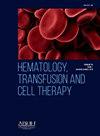Assessing the role of bronchoscopy in the management of patients with acute leukemia—a transversal study and proposal of evaluation
IF 1.8
Q3 HEMATOLOGY
引用次数: 0
Abstract
Introduction
Bronchoscopy is frequently performed in the management of patients with acute leukemia due to their high susceptibility to infections. In this setting, it is performed in the context of lung infiltrates on imaging and persistent fever in immunocompromised subjects. This study aimed to evaluate the utility of bronchoscopy in patients with acute leukemia, its diagnostic yield, and its impact on management decisions.
Methods
This is a single-center cross-sectional study that included patients diagnosed with acute leukemia of any phenotype who received intensive chemotherapy. Consecutive patients who underwent bronchoscopy as part of a work-up for associated infections were selected, while patients who had undergone bone marrow transplant were excluded. This study investigated patient characteristics and the impact of bronchoscopy on changes in clinical management.
Results
Seventy-nine patients who underwent bronchoscopy at various stages of treatment were analyzed. The most frequent type of acute leukemia was acute myeloid leukemia, accounting for 68.3 % of cases. The induction phase was the most prevalent (29.1 %) treatment stage. Bacterial cultures were positive in 17 out of the 74 patients evaluated, with Pseudomonas aeruginosa being the most frequently identified microorganism. A change in medical management was observed in 18.2 % of cases, and only six patients experienced secondary complications.
Conclusions
This is the first Brazilian study to evaluate the utility of bronchoscopy in managing infectious complications in patients with acute leukemia. The impact of bronchoscopy on clinical management was less than anticipated, largely due to its low yield in identifying causative agents. Nevertheless, it remains a safe procedure and can be useful in specific situations.
评估支气管镜检查在急性白血病患者治疗中的作用——一项横向研究和评价建议
由于急性白血病患者易受感染,支气管镜检查是治疗急性白血病的常用手段。在这种情况下,它是在影像学上肺部浸润和免疫功能低下患者持续发烧的情况下进行的。本研究旨在评估支气管镜检查在急性白血病患者中的应用,其诊断率及其对治疗决策的影响。方法:这是一项单中心横断面研究,纳入了接受强化化疗的任何表型急性白血病患者。连续接受支气管镜检查作为相关感染检查的一部分的患者被选中,而接受骨髓移植的患者被排除在外。本研究探讨了患者的特点和支气管镜检查对临床管理变化的影响。结果对79例不同治疗阶段的支气管镜患者进行了分析。急性白血病最常见的类型是急性髓系白血病,占病例的68.3%。诱导期是最常见的治疗期(29.1%)。74例患者中有17例细菌培养呈阳性,其中铜绿假单胞菌是最常见的微生物。18.2%的病例发生了医疗管理的改变,只有6例患者出现了继发性并发症。结论:这是巴西首个评估支气管镜在急性白血病患者感染性并发症治疗中的应用的研究。支气管镜检查对临床管理的影响小于预期,主要是由于其在确定病原体方面的低收益。尽管如此,它仍然是一个安全的程序,在特定情况下可能有用。
本文章由计算机程序翻译,如有差异,请以英文原文为准。
求助全文
约1分钟内获得全文
求助全文
来源期刊

Hematology, Transfusion and Cell Therapy
Multiple-
CiteScore
2.40
自引率
4.80%
发文量
1419
审稿时长
30 weeks
 求助内容:
求助内容: 应助结果提醒方式:
应助结果提醒方式:


